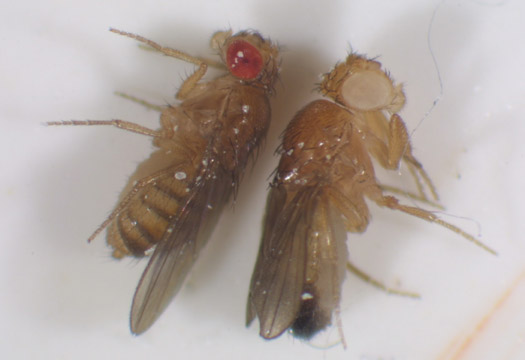Gender determination
It is imperative that you be able to reliably differentiate between male and female flies! In future phenotyping and crosses a mistake in sexing one fly can ruin the experiment!

Fig. 3. Lateral view of Drosophila melanogaster showing gender differences. The arrow points to the male sex comb.
The anatomy of male and female D. melanogaster varies in several ways. Generally, the abdomens of males tend to be stubbier and more darkly pigmented than females (Fig. 3). However, this is NOT a reliable way to distinguish between the two genders, since all newly eclosed flies tend to have lighter pigmentation and elongated abdomens. An extremely reliable feature is the sex comb, a feature found only on males. The sex comb is a set of bristles found midway down the front legs. The individual bristles of the sex combs generally can't be distinguished under a dissecting scope; rather, the sex comb appears as a black blob (at tip of arrow in Fig. 1). If you can see a sex comb, you know that the individual is a male. If you don't see a sex comb, the individual either is a female or you haven't looked hard enough. To convince yourself that a fly is a female, you should roll the anesthetized fly around using your paintbrush and examine the front legs from several angles to be sure that the sex combs actually are not there.

Fig. 4. Ventral view of D. melanogaster showing gender differences.
Fig. 4 shows the gender differences from a ventral view. Again, the sex combs in the male appear as black blobs on the forelegs. Another reliable character that can be used to differentiate the genders is the lateral plate of the male genitalia. It is a brownish, oval plate on the ventral surface of the male's abdomen near the posterior end. Although more difficult to describe than the sex combs, with practice it is perhaps a more easily recognized trait than the sex combs and it is probably more apparent that it is NOT present in females. The lateral plate is also easily seen in newly eclosed male flies.
Mutant phenotypes

Fig. 5. Wild type fly (left) and triple mutant fly (right)
The mutant flies we are examining this week have three differences in their phenotypes from the wild type (+) flies. These differences are apparent in Fig. 5. The most noticeable difference is the white eye (w) mutation, which is an obvious difference from the red eyes of the wild type fly. The miniture wing (m) mutation is also apparent in Fig. 5. The wings of flies with the miniture wing phenotype do not extend significantly beyond the end of the abdomen, whereas the wild type wings extend well beyond the abdomen. The third mutation, forked bristle (f) is also visible in this image, but is more apparent in Fig. 6.b.
Take note that it is not possible to know which phenotype a newly-eclosed fly has for the wing trait, since the wings do not unfold for some time after the emergence from the pupal case.

Fig. 6.a. Lateral view of wild-type fly.

Fig. 6.b. Lateral view of triple mutant fly.

Fig. 6.c. Close up view of forked bristle morphology
Fig. 6 again illustrates the differences in the three phenotypes involved in our experiment. The forked-bristle phenotype is the most difficult of the three to identify. The name "forked" is actually somewhat misleading. Occasionally, a bristle with an abnormal morphology caused by the mutation will be forked. But abnormal bristles can also appear hooked, knobed, thick and stubby, or misshapen in other ways (Fig. 6.c.). In contrast, normal bristles are long, thin, and tapering to a point.
On a fly with the forked bristle phenotype, most bristles do NOT display an abnormal appearance. Only bristles at the posterior end of the dorsal side of the thorax (near the base of the wings; Fig. 6.b.) can reliably be found to display an abnormal shape and it may not be seen in every bristle, even at that location. If even one bristle at that location has the abnormal shape, the fly has the forked bristle trait. In flies with the wild type bristle phenotype, every bristle at that location will be long, thin, and tapering (Fig. 6.a.).
It is critical that you learn to identify all three mutant phenotypes this week. This week it is easy to know which flies are mutants, because a fly with any mutant trait (e.g. white eyes) will also have the other two mutant traits. That will NOT necessarily be the case in subsequent weeks of the experiment where a fly might have red eyes, long wings, but forked bristles. Thus you should be able to score any of the three phenotypes independently on a particular fly.
